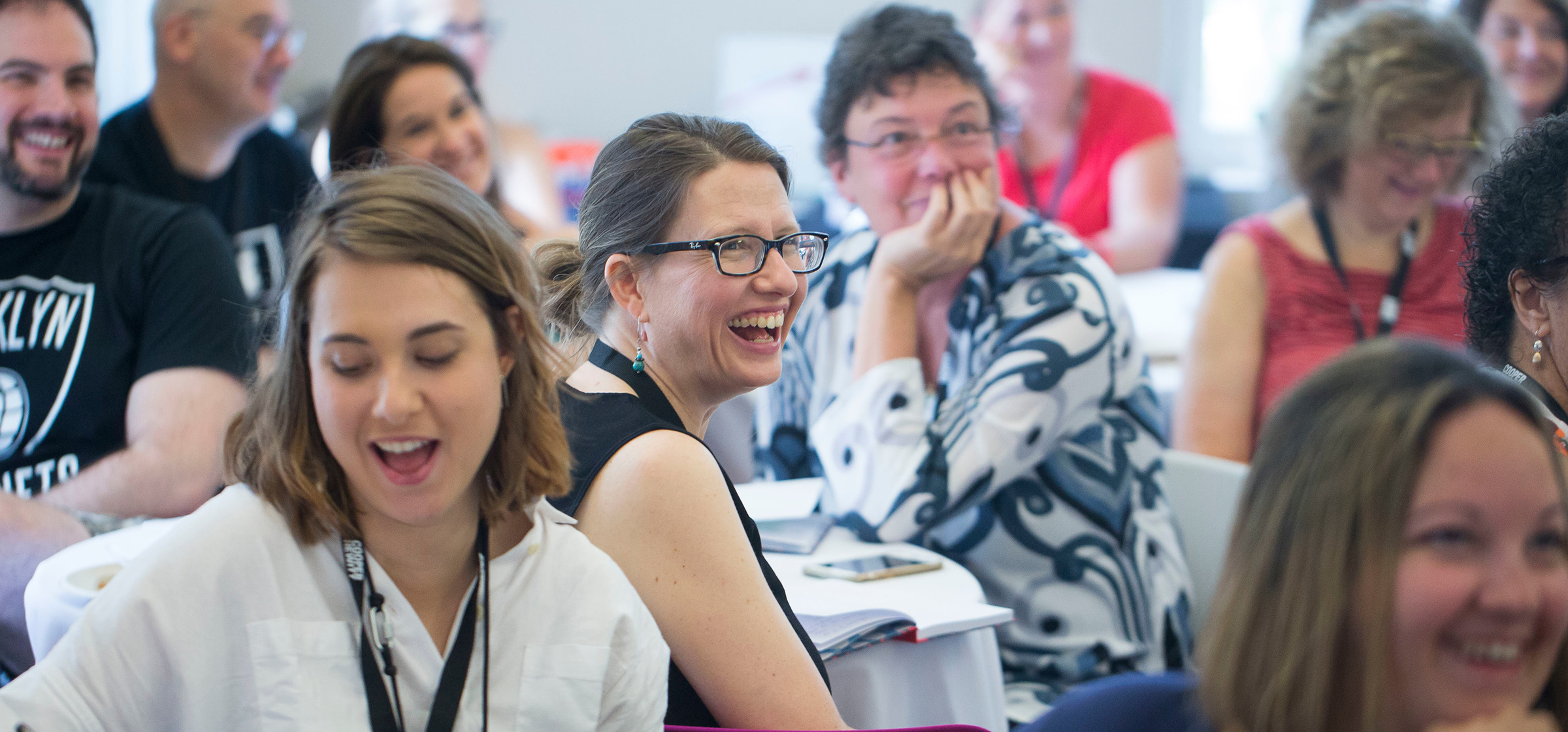July 11-13, Cooper Hewitt, Smithsonian Design Museum hosted its Design Thinking Workshop for 30 K-12 educators invited from across the country for an immersive how-to on integrating designer methodology into the classroom.
“We’re all educators here. You’re my people!” Director of Education Ruki Ravikumar welcomed the group of selected computer science educators, art educators, English educators and school principals.
Professional Development Manager Michelle Cheng reassured the room that all presentation slides would be made available. “No need to take notes,” she said. But this was a room filled with educators. The scratch of scrawling pens in notebooks did not cease then, or at any point over the three-day workshop.
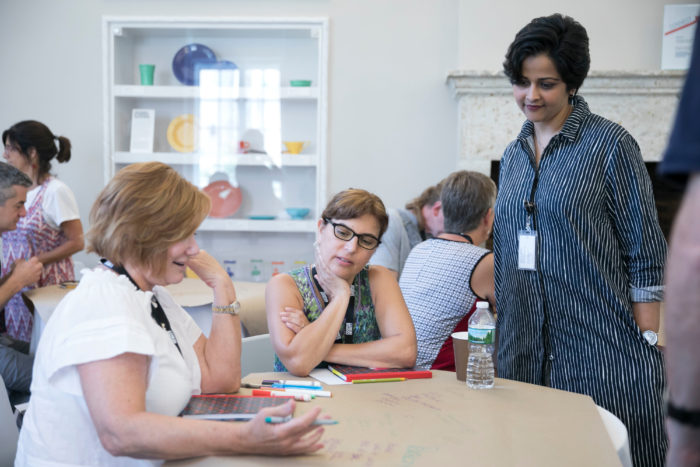
Director of Education Ruki Ravikumar presents and assists during the brainstorming stage of the design process, where educators identify specific issues they face and begin to think about solvability. Photo by Ben Hider
Over three days, participants heard from a diverse range of designers and non-designers about design’s application in education, toured the museum collection, and collaborated with one another in small teams on a culminating project. This element saw educators implement the museum’s imparted resources by defining a problem observed in their classrooms, and brainstorming and prototyping design solutions.
The workshop is part of Cooper Hewitt’s larger Design in the Classroom initiative, a campaign to ensure every child in every school nationwide is introduced to design and design thinking. The project’s plan includes the facilitation and demonstration of integrating the design process into the classroom setting, making world-class designers available to educators, and making Cooper Hewitt resources for educators accessible online.
Michelle defined design thinking for participants as an ethos concerned with “process, and not necessarily about the end product.” Design thinking emphasizes collaboration, problem solving, and critical thinking skills.
Michelle opened her presentation with a role-playing activity, establishing the mindset intended for the program. She asked the educators to turn to a partner and plan a party. In the first round, one person suggests ideas and one person rejects all of them with “No, because…” In the second round, the ideas are all accepted and built upon with “Yes, and…” The energy shift was noticeable, with the room becoming louder, voices more animated. “Being creative does not mean being able to draw well,” Michelle said. “It means being able to generate those wild ideas and problem solve.”
Among the workshop’s speakers was Jessica Hurwit, Senior Product Designer at Michael Graves Architecture & Design. Jessica explained how the firm used design problem solving to update the wheelchair for the hospital environment, first by recognizing its problems: its original form that has remained largely unchanged for eighty-four years, the negative connotations associated with having to use a wheelchair, and the high theft rate of wheelchairs at hospitals. Step by step, Jessica presented to and involved her audience, prompting participants to ask the same questions the Graves team might have asked, to draw the same initial prototypes the Graves team might have sketched. The educators always returned the discussion to the rational element of helping users, asking, “Is the new design just aesthetic?” and “How much can its function be improved?” When Jessica revealed the firm’s final design, the Prime TC for Stryker Medical, it felt like an accomplishment for everyone in the room.
Ian Kastelic, District Science Teacher on Special Assignment for the San Mateo-Foster City School District in Foster City, Calif., hopes to incorporate the presentation directly into his work with K-8 educators. “To show our students the three-year journey of this company [to make this product]… it would be invaluable,” Kastelic said.
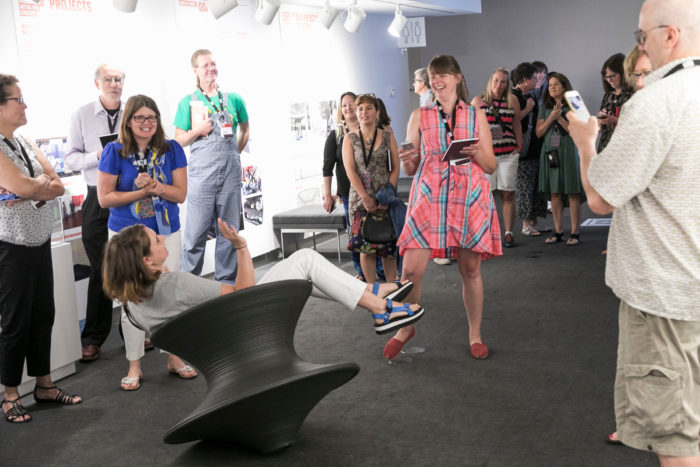
Educators took a break with turns on Thomas Heatherwick’s Spun Chairs, found on Cooper Hewitt’s ground floor. One group later incorporated them into their design solution of tailoring classroom experiences to different personalities. The chairs are disorienting and at first disconcerting; some students would be eager to spin on the chair, some students would be hesitant, and so on. The group considered how to cater to these different students by providing multiple options and open frameworks. Photo by Ben Hider
For the educators, their design challenge was derived from turning the question of “How might we…” onto improving their own classrooms and schools, and their students’ experiences. During this process, designer Jason Bacher advised on the importance of risk-taking. Highlighting case studies of his firm’s failed projects, Jason demonstrated what can be gleaned from fearless attempt. His message resonated with workshop participants.
“I think students are afraid of failure,” Molly Reisman, STEM educator at MEFE Career Pathways School in Minneapolis, said. “I want them to not be afraid, but I also want them to still try their best. So now I want to reframe it as taking a risk.” It is the experience of processes and empirical discovery that matters. Failure is inherent and necessary in design thinking.
Apryl West, 9th and 10th grade literature and visual and performing arts teacher at Riverside STEM Academy in Riverside, Calif., is thinking about risk-taking from either side. “Both [students and teachers] are afraid to try something new. Teachers are afraid to step out of their comfort zone, for fear that chaos might ensue. The kids pick up on that,” Apryl said. When educators take a risk in their own teaching practices—of drawing up a curriculum, say—it could in fact influence the process of learning on the part of their students.
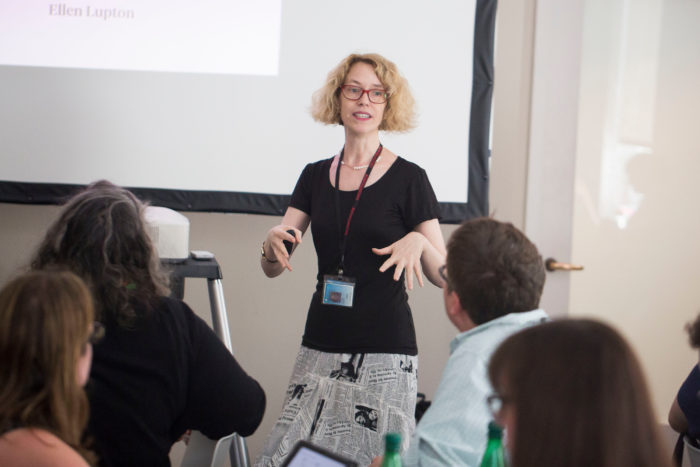
Senior Curator of Contemporary Design Ellen Lupton gave a presentation from her latest book, Design Is Storytelling, to be released in November 2017. In the creative thinking playbook she writes, “Design teams use personas to imagine how different people with different desires and abilities will experience your tool or service. The characteristics of a persona can include general demographics (such as gender, age, and income) as well as specific quirks and interests (such as collecting antique cars or growing heirloom melons).” Photo by Ben Hider
Over the three days of workshopping, more voices joined the discussion of process. Cooper Hewitt’s own Ellen Lupton, Senior Curator of Contemporary Design at the museum, Director of the Graphic Design MFA program at Maryland Institute College of Art, and award-winning author, presented her philosophy of shifting emphasis from objects to actions. Designers must think about creating experiences for users, Lupton said, which in the classroom may translate to anticipating student response to material.
Lindsay Miller, ceramicist and art teacher at Towson High School in Baltimore, is interested in design’s functionality in her own practice. She is currently working on a design challenge for her students that would receive a Lupton stamp of approval: “Creating a specific user that they have to create an object for, and it can’t be themselves,” she said. “And I’m trying to figure out how to go beyond that.”
Molly had a suggestion, a few tables away (by the workshop’s second afternoon, the floor has entirely opened up to free-flowing conversation, with biology teachers from Georgia advising drawing teachers from Maryland). “[A teacher could] help students create the characters they are designing for, to expand the kinds of people kids are imagining and thinking about,” Molly offered. “That’s part of empathy.”
Tova Kleiner, winner of the 2017 National High School Design Competition, demonstrated the role of empathy in the design process. Tova, a 14-year-old from New York City, shared the dialogue that she had with her grandmother, that then inspired her to solve the design challenge of improving a community’s access to fresh foods. Empathy, the step that requires a designer to relate to a user and understand the user’s needs, was carried to the workshop’s conclusion as it was manifested in participants’ prototypes for their designed plans and products to solve a classroom problem. One group addressed their schools’ problem of students falling behind after a few days out by offering support for those students instead of punishment. They designed digital and hard copies of worksheets to help students catch up on missed work. Another group identified their issue of students’ attachment to technology device use. Their design solution involved a prototype for a lamp with red, yellow and green lights to gently signal when it is and is not acceptable for students to be on their screens.
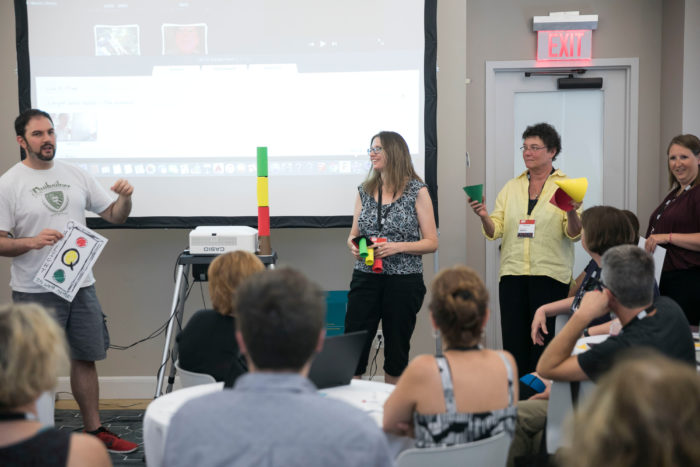
Presenting their prototype, a group showed an infomercial video and construction paper prototypes for their “Que Light.” The lamp features red, yellow and green lights to signal when it is and is not acceptable for students to be on their technological devices. If created, they hoped to incorporate sound to increase accessibility. Photo by Ben Hider
When the Design Thinking Workshop ended, the participating educators took learned and created tools home with them, in addition to a continued relationship with Cooper Hewitt resources. “The impact of our Design Thinking Workshops is reinforced through the availability of lesson plans and other materials online, both on Cooper Hewitt’s website and through the Smithsonian’s Learning Lab,” Michelle said. The online Learning Lab is about discovery, creation and sharing for educators and students, offering over two million images, recordings, and texts from all 19 Smithsonian museums, 9 major research centers and the National Zoo that can be incorporated and personalized for individual classrooms. As Design in the Classroom expands its outreach, Cooper Hewitt will continue to expand its presence on the Learning Lab so that resources for sharing design thinking in the classroom are available nationally.
